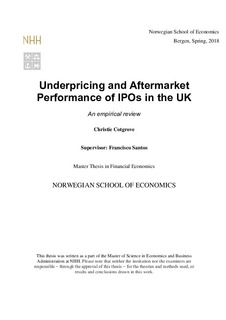Underpricing and aftermarket performance of IPOs in the UK : an empirical review
Master thesis
Permanent lenke
http://hdl.handle.net/11250/2560964Utgivelsesdato
2018Metadata
Vis full innførselSamlinger
- Master Thesis [4372]
Sammendrag
This thesis contributes to the literature on Initial Public Offerings (IPOs). It seeks to uncover
and explain underpricing and aftermarket performance for companies that go public for the
first time in the United Kingdom (UK).
By creating a novel dataset of 194 UK IPOs that occur between 2006 and 2017, I find evidence
that the UK IPOs exhibit first day returns equal to 7.4%. The underpricing is evident in all the
years examined, showing that positive first day returns are a consistent phenomenon. IPOs
that are issued during periods of above average first day returns, called hot markets, exhibit an
average underpricing of 12.6%. Further, IPO firms that have higher profit margins in the year
prior to the IPO, experience a positive 0.2% addition to their first day return on average.
Finally, private-equity backed IPOs exhibit significantly lower first day returns of 3.1% on
average, while their venture-backed counterparts do not.
Regarding aftermarket performance, I find varying evidence of outperformance and
underperformance depending on the benchmark and method employed. My IPO sample
significantly outperforms the FTSE benchmarks on a six-month basis, but for the longer
periods of one-, three-, and five-years the results are inconclusive. Further, the wealth relatives
confirm that the IPOs outperform the benchmark for the six-month holding period, showing a
wealth relative equal to 1.06 and 1.05 when compared to FTSE All Share Index and the FTSE
Small Cap Index, respectively. For the six-month holding period, private equity-backed IPOs
increase returns by about 18%, while the one-year holding period is even more pronounced,
increasing returns approximately 30%. Finally, I use the CAPM (Sharpe 1964), the FamaFrench
three-factor model (Fama and French 1993), and a newer three-factor model by Asness,
Moskowitz et al. (2013) to examine abnormal returns of the IPOs in terms of alpha. However,
none of the factor models show significant alphas.
